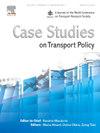Investigating the perception of tourists for developing bus service as an attractive mode for Tourism: A case study of Kerala, India
IF 3.3
Q3 TRANSPORTATION
引用次数: 0
Abstract
Inferior service quality of the transportation facilities is a major deterrent to choose emerging countries as tourist destinations despite having incredible tourism potential. Realizing the need for providing quality services satisfying the expectations of tourists, the study presents an approach to identify key intervention areas for developing bus service as an attractive mode for tourism. The policy intervention areas are identified based on a fuzzy based importance-satisfaction analysis (fuzzy-ISA) giving due consideration to the factor structure of the tourists and management scheme of service. The study also develops an econometric Generalized Cost (GC) model for quantifying the benefits due to the improvement of bus service. A route-based sensitivity analysis was conducted, and it was instrumental in quantifying the potential benefits due to the improvement of qualitative attributes such as an information, safety and security, and crowding level. Considering the financial constraints of emerging countries, the study identifies short-term and long-term objectives for augmenting the quality of bus service in the context of tourism. The study also proposes the introduction of premium buses for serving tourists locations and a detailed route-based investigation and design based on the insights (intervention areas and GC model) derived from the present work. While the findings are case-specific, the methodology and approach would be instrumental for improving service in other countries irrespective of the prevailing socio-demographics.
调查游客对发展巴士服务作为一种有吸引力的旅游模式的看法:以印度喀拉拉邦为例
尽管新兴国家拥有巨大的旅游潜力,但交通设施的服务质量较差是选择新兴国家作为旅游目的地的主要障碍。本研究以提供符合游客期望的优质服务为出发点,提出了一种方法,以确定巴士服务发展为具有吸引力的旅游模式的关键干预领域。在考虑游客因素结构和服务管理方案的基础上,采用模糊重要性满意度分析(fuzzy- isa)确定政策干预区域。本研究亦建立了一个计量广义成本(GC)模型,以量化巴士服务改善所带来的效益。进行了基于路线的敏感性分析,该分析有助于量化由于信息、安全和安保以及拥挤程度等定性属性的改善而带来的潜在效益。考虑到新兴国家的财政限制,该研究确定了在旅游业背景下提高公共汽车服务质量的短期和长期目标。该研究还建议引入优质巴士服务于游客地点,并根据从本工作中得出的见解(干预区域和GC模型)进行详细的基于路线的调查和设计。虽然调查结果是针对具体情况的,但其方法和办法将有助于改善其他国家的服务,而不论其普遍的社会人口情况如何。
本文章由计算机程序翻译,如有差异,请以英文原文为准。
求助全文
约1分钟内获得全文
求助全文

 求助内容:
求助内容: 应助结果提醒方式:
应助结果提醒方式:


